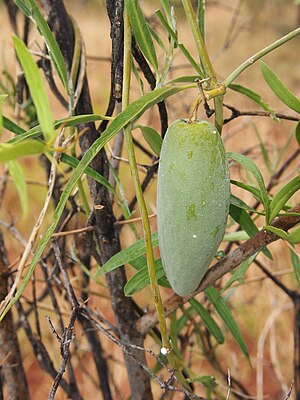Bush banana
| Bush banana | ||||||||||||
|---|---|---|---|---|---|---|---|---|---|---|---|---|

Fruit of the bushbane |
||||||||||||
| Systematics | ||||||||||||
|
||||||||||||
| Scientific name | ||||||||||||
| Marsdenia australis | ||||||||||||
| ( R.Br. ) Druce |
The bush banana ( Marsdenia australis , Syn .: Leichhardtia australis R.Br.) is a plant species in the subfamily of the silk plants (Asclepiadoideae) within the family of the dog poison plants (Apocynaceae). The species, which only occurs in Australia, grows in Central Australia and continuously in Western Australia . Plant parts of the bush banana were an important foodstuff as so-called bush food, which the Aborigines in particular eat.
description
Marsdenia australis grows as a climbing climber and reaches heights of up to 4 meters. It forms tubers with a diameter of up to 16 cm as persistence organs. The bark on young stems is hairy, on older stems it is rarely smooth. There is white milky juice .
The 2 to 15 mm long, stalked, linear-lanceolate leaves are usually 3 to 12 cm long and 2 to 8 mm wide and 10 to 18 times longer than they are wide. They have entire margins, often folded in, usually pointed, plump and slightly fleshy with a prominent middle nerve and usually with one to five tiny glands at its base.
Six to 19 flowers stand together in a 3 to 15 mm long stalked, dold-like inflorescence . The 3 to 15 mm long stalked, hermaphrodite and five-fold flowers with a double perimeter have a diameter of about 4 to 5 mm and are five-fold and greenish to yellow. The five sepals are 2 to 4 mm long. The five 6 to 8 mm long, egg-shaped petals are fused with 3 to 4 mm long corolla lobes. The stamens are fused with the gynostegium . The flowering period extends from late spring to summer.
The thick-walled, hairless and brownish follicle fruits when ripe have a length of 4 to 10 cm and a diameter of 2.5 to 3.5 cm. The head of hair of the cone-shaped seeds is 20 to 40 mm long.
etymology
The generic name Marsdenia honors William Marsden (1754-1836), an Irish orientalist and numismatist . The specific epithet australis is Latin and means south. The valid name Marsdenia australis ( R.Br. ) Druce was given in 1917 by George Claridge Druce in Bot. Soc. Exch. Club Brit. Isles , 4, 634. The name Leichhardtia australis goes back to the German explorer , zoologist , botanist and geologist Ludwig Leichhardt (1813–1848). It was first published as Leichardtia australis in 1849 by Robert Brown : Cogola Bush in Sturt, fool. Exped. Cent. Austral. , 2, app .: 81.
English common names are Doubah , Native Pear , Austral Doubah , Cogola Bush , Bush banana , Silky Pear or Green vine .
The bush banana has different names in the Aboriginal languages . In the language of the Arrernte in Central Australia it is called merne alangkwe (older transcription: elonka ), merne ulkantyerrknge (the flower) and merne altyeye (the prefix merne denotes the fruits of plants). The plant can be eaten early as well as fully grown. The small fruits are called amwerterrpe . The place Kalgoorlie is named after the word of the Wangai -Aborigines Karlkurla, which means place of silky pears (German: place of the silky pears).
food
The bush banana spreads like wild wine , hence the common name Green vine , and also climbs up on other plants. The sweet-tasting flowers hang from the plant in small bunches and are edible; for the Arrernte Aborigines they are the most important part of the plant (altyeye).
Bush bananas are cooked in hot earth next to the fire or the young ones are eaten raw (the taste can be compared to fresh peas). The seeds of young fruits are consumed roasted, those of the older ones are bitter and are not eaten. The whitish roots are called merne atnetye and are cooked in hot earth next to the fire, but only in times of need. The fine roots are not edible, but young sprouts and the leaves are.
The bush bananas are eaten in the central deserts of Australia today. It is one of the most important edible plants for the Aborigines.
Art and mythology
This edible plant species is depicted in Aboriginal art , particularly in paintings about the bush tucker , as well as paintings in so-called Bush Banana Dreamings of Dreamtime . The plant is of great importance as a totem for the Aborigines. The Aboriginal artists Christopher Japangardi Poulson / Yuparli Jukurrpa , Deidrie Napangardi Brown, Janet Forrester Ngala and Dorothy Abbott Napangardi painted pictorial and symbolic representations .
swell
- GJ Harden, JB William: in New South Wales Flora Online : Marsdenia australis .
Web links
Individual evidence
- ^ Peter Kenneth Latz, Jenny Green: Bushfires & Bushtucker: Aboriginal Plant Use in Central Australia , IAD Press, 1995, ISBN 0-949659-83-5 .
- ↑ a b Travel Australia with AusEmade - Flora and Fauna - Bush Banana: Artist's impression on Aboriginal paintings .
- ^ Baldwin Spencer, Francis James Gillen: The Arunta: a study of a stone age people , p. 311, Macmillan, 1927, repr. Anthropological Publications, 1966.
- ↑ Bush banana. Leichhardtia . In: Ausemade without date, accessed on April 25, 2020.